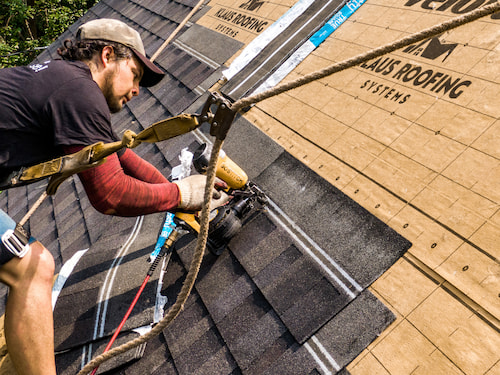Is Your Roof at Risk? Hidden Storm Damage Homeowners Often Miss

We are all aware of the recent storms here in Connecticut. Heavy rainfall and high winds caused damage to homes, properties, and roads. While we might notice the obvious damage around our property and throughout our town, our roof could be hiding significant issues that aren’t immediately visible. Unseen roof damage after a storm is a common problem that can lead to costly repairs if not addressed promptly. Here’s what you need to know to protect your home.
The Hidden Impact of Storms on Your Roof
Your roof is tough, it’s built to handle all kinds of weather. But even the best roofs have their limits. After a big storm with strong winds, heavy rain, hail, or flying debris, there could be damage you just can’t see from the ground. Everything might look fine at first, but that doesn’t always mean your roof came through unscathed. Hidden damage is more common than you’d think, and it can show up in a few sneaky ways:
Lifted or Loosened Shingles
High winds can lift shingles, breaking the seal and making them more vulnerable to being blown off when the next weather event arrives. Shingles may appear to be intact; however, the seal might be compromised, leading to leaks over time.
Granule Loss
Heavy rain, hail, and snow can cause granules to erode from asphalt shingles. While some granule loss is normal, excessive loss can expose the underlying material (underlayment and decking) to UV rays, which accelerates aging and reduces the roof’s lifespan.
Cracked or Dented Shingles
Hailstones and even excessive rain can crack or dent shingles, specifically those that are older or lower-quality. While not visible from the ground, these cracks and dents can allow water to seep into the roof deck. Learn more about this on our blog on Understanding Storm and Hail Damage to Roofs in Connecticut.
Roof Leaks
Even small cracks or gaps can let water in, which might not result in visible water damage immediately. Over time, moisture can accumulate in your attic or behind walls, leading to mold growth, wood rot, and structural damage. Here's how to spot a roof leak before it grows.
Flashing Damage
Flashing, the material used to seal joints and seams around chimneys, vents, and skylights, can be loosened or damaged by high winds and flying debris. Damaged flashing can cause leaks that are difficult to detect until significant water damage has occurred.
The Importance of a Professional Roof Inspection

A professional can spot roof problems early and fix them the right way.
After a storm, it is important to have your roof inspected by a local, licensed professional roofing contractor. In towns like Guilford, Orange, Prospect, West Haven, and Darien, where heavy wind and rain are common, it just makes sense to stay ahead of the damage. An inspection now can save you a headache later.
Even if you don’t see any obvious damage, a trained roofer can identify subtle evidence of damage that the average person might miss. They’ll check for issues like lifted shingles, cracks and curling, granule loss, and flashing damage. A thorough roof inspection can ensure that any problems are caught early.
What to Do If Damage Is Found

Storm damage in Stamford, Bridgeport, or Waterbury? If you see missing shingles or debris, schedule a roof inspection right away.
If your roof inspection reveals damage, it’s essential to act quickly. Delaying repairs can lead to more severe issues, such as leaks, mold growth, and structural damage. Below are the steps you should take.
- Have Your Roofing Professional Document the Damage: After a storm, a qualified roofer can help you prove that damage occurred. Make sure they take detailed photos, write up a clear report, and keep records of all inspections and repairs. This documentation can make all the difference if you need to file an insurance claim.
- Contact Your Insurance Company: Report the damage to your insurance company immediately. Insurers will likely send an adjuster to assess the damage and determine coverage.
- Hire a Reputable Roofing Contractor: Choose a local roofing contractor who is licensed, insured, and experienced with storm damage repairs. Roofing is dangerous work, so always ask to see proof of insurance to make sure they’re fully covered. Look for someone who understands the insurance claims process and knows the local building codes. The right contractor will make the repairs safely, properly, and without added stress.
- Consider Preventative Measures: Once your roof is repaired, consider investing in preventative measures, such as installing impact-resistant shingles or reinforcing vulnerable areas, to better protect your home from future storms.
Work With a Roofer Who Knows the Claims Process
Choose a professional roofing company that:
- Has experience with storm damage claims
- Knows how to work with adjusters
- Helps gather and submit documentation
- Can meet your insurer’s requirements
One Quick Inspection Could Save You Thousands. Call Now to Get Started.
Storms can do more damage to your roof than you might think, and it's not always easy to spot. Catching problems early can save you from expensive repairs later. A quick inspection after a big storm can make all the difference. Once you see water stains on the ceiling, it means the damage has already spread. Don’t wait for it to get worse. Get your roof checked while the fix is still simple.
Live in West Haven, Darien, Guilford, Orange, or Prospect? We’re already in the neighborhood. Brown Roofing makes it simple to get a free inspection and honest estimate. Just give us a call and we’ll take care of the rest.
Schedule a roof inspection and free estimate with Brown Roofing today!
Updated July 31, 2025


